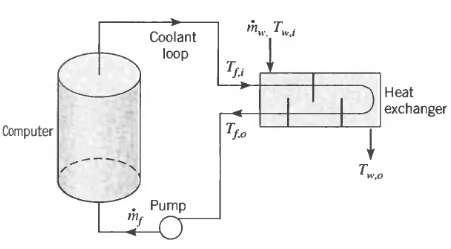In a supercomputer, signal propagation delays are reduced by resorting to high-density circuit arrangements which are cooled
Question:
In a supercomputer, signal propagation delays are reduced by resorting to high-density circuit arrangements which are cooled by immersing them in a special dielectric liquid. The fluid is pumped in a closed loop through the computer and an adjoining shell-and-tube heat exchanger having one shell and two tube passes.
During normal operation, heat generated within the computer is transferred to the dielectric fluid passing through the computer at a flow rate of mf = 4.81 kg/s. In turn, the fluid passes through the tubes of the heat exchanger and the heat is transferred to water passing over the tubes. The dielectric fluid may be assumed to have constant properties of cp = 1040 J/kg ? K, ? = 7.65 X 10?4 kg/s ? m, k = 0.058 W/m ? K, and Pr = 14. During normal operation, chilled water at a flow rate of mc = 2.5 kg/s and an inlet temperature of Tw,i = 5?C passes over the tubes. The water has a specific heat of 4200 J/kg ? K and provides an average convection coefficient of 10,000 W/m2 ? K over the outer surface of the tubes.
(a) If the heat exchanger consists of 72 thin-walled tubes, each of 10-mm diameter and fully developed flow is assumed to exist within the tubes, what is the convection coefficient associated with flow through the tubes?
(b) If the dielectric fluid enters the heat exchanger at Tf,i = 25?C and is to leave at Tf,o = 15?C, what is the required tube length per pass?
(c) For the exchanger with the tube length per pass determined in part (b), plot the outlet temperature of the dielectric fluid as a function of its flow rate for 4 mf 6 kg/s. Account for corresponding changes in the overall heat transfer coefficient, but assume all other conditions to remain the same.
(d) The site specialist for the computer facilities is concerned about changes in the performance of the water chiller supplying the cold water (mw, Tw,i) and their effect on the outlet temperature Tf,o of the dielectric fluid. With all other conditions remaining the same, determine the effect of a + 10% change in the cold water flow rate on Tf,o.
(e) Repeat the performance analysis of part (d) to determine the effect of a + 3?C change in the water inlet temperature on Tf,o, with all other conditions remaining the same.

Step by Step Answer:

Fundamentals of Heat and Mass Transfer
ISBN: 978-0471457282
6th Edition
Authors: Incropera, Dewitt, Bergman, Lavine





